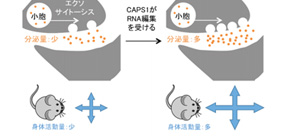
Role of Molecular Modification in Determining Physical Activity Levels Revealed
Will lead to further understanding of how physical activity is regulated at the cellular level in the nervous system
To generate functional products, the information contained in genes is transcribed into a molecule called RNA. RNA is then modified in numerous ways, either for the subsequent production of proteins or for a range of activities of the RNA itself. One rare type of modification is called RNA editing, whereby the RNA’s actual sequence is directly changed. However, little is understood about the effects of such editing because few animal models exclusively expressing the edited or unedited version of such RNA have been created.
In a new study, Japanese researchers centered at Osaka University have revealed the importance of RNA editing by manipulating a gene whose product, called CAPS1, undergoes RNA editing. Specifically, they created mutant mice that exclusively expressed the edited form of CAPS1. These mice moved around more and weighed less than their normal counterparts, revealing the involvement of RNA editing in regulating physical activity.
CAPS1 is involved in a process called vesicle exocytosis, in which cell contents are segregated into compartments, which fuse to the outer membrane of cells and are then expelled. When mice expressed only the RNA-edited version of CAPS1, this vesicle exocytosis occurred much more actively, as reflected in greater release of radioactively labeled dopamine from brain. This revealed the importance of RNA editing for neuronal functions.
“What was really interesting was the effects of increased vesicle exocytosis on mice at the anatomical and behavioral levels,” study corresponding author Yukio Kawahara says. “Although they weren’t consuming more food or water, they were using up more oxygen, so their metabolism was higher.”
“We looked for reasons for this higher metabolism, including by measuring their levels of movement in a controlled environment,” he says. “They were much more active than the control group, which in turn led to them having a lower body weight.”
The fact that the RNA editing, involving only a single “letter” change in the sequence of CAPS1, had such pronounced effects reveals the power of this process. This study increases understanding of how exocytosis is regulated and the wider effects of this regulation on organisms. It should also intensify interest in this type of molecular modification among researchers, which should in turn lead to further insights into this exciting field of study.
The article “CAPS1 RNA Editing Promotes Dense Core Vesicle Exocytosis” was published in Cell Reports at http://dx.doi.org/10.1016/j.celrep.2016.10.073

Figure. RNA editing of CAPS1 enhances vesicle exocytosis, leading to secretion of dopamine more efficiently and increased physical activity in mice.
To learn more about this research, please view the full research report entitled “CAPS1 RNA Editing Promotes Dense Core Vesicle Exocytosis” at this page of Cell Reports .
Related link
